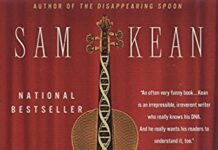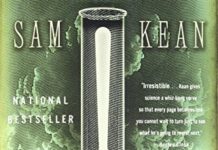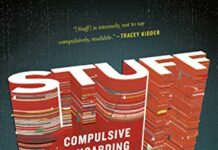
Ebook Info
- Published: 2011
- Number of pages: 416 pages
- Format: Epub
- File Size: 1.02 MB
- Authors: Sam Kean
Description
Why did Gandhi hate iodine (I, 53)? How did radium (Ra, 88) nearly ruin Marie Curie’s reputation? And why is gallium (Ga, 31) the go-to element for laboratory pranksters?
The Periodic Table is a crowning scientific achievement, but it’s also a treasure trove of adventure, betrayal, and obsession. These fascinating tales follow every element on the table as they play out their parts in human history, and in the lives of the (frequently) mad scientists who discovered them. The Disappearing Spoon masterfully fuses science with the classic lore of invention, investigation, and discovery — from the Big Bang through the end of time.
Though solid at room temperature, gallium is a moldable metal that melts at 84 degrees Fahrenheit. A classic science prank is to mold gallium spoons, serve them with tea, and watch guests recoil as their utensils disappear.
User’s Reviews
Review “Kean…unpacks the periodic table’s bag of tricks with such aplomb and fascination that material normally as heavy as lead transmutes into gold. A-“―Keith Staskiewicz, Entertainment Weekly”Kean’s writing sparks like small shocks…he gives science a whiz-bang verve so that every page becomes one you cannot wait to turn just to see what he’s going reveal next.”―Caroline Leavitt, The Boston Globe”[Kean turns] The Disappearing Spoon into a nonstop parade of lively science stories…ebullient.”―Janet Maslin, New York Times”Kean’s palpable enthusiasm and the thrill of knowledge and invention the book imparts can infect even the most right-brained reader.”―Christine Thomas, Miami Herald”With a constant flow of fun facts bubbling to the surface, Kean writes with wit, flair, and authority in a debut that will delight even general readers.”―Publishers Weekly”Nearly 150 years of wide-ranging science…and Kean makes it all interesting. Entertaining and enlightening.”―Kirkus”Only once in a rare while does an author come along with the craft and the vision to capture the fun and fascination of chemistry. The Disappearing Spoon is a pleasure and full of insights. If only I had read it before taking chemistry.”―Mark Kurlansky, author of Salt and Cod “If you stared a little helplessly at the chart of the periodic table on the wall of your high school chemistry class, then this is the book for you. It elucidates both the meanings and the pleasures of those numbers and letters, and does so with style and dash.”―Bill McKibben, author of Eaarth: Making a Life on a Tough New Planet”The Disappearing Spoon shines a welcome light on the beauty of the periodic table. Follow plain speaking and humorous Sam Kean into its intricate geography and stray into astronomy, biology, and history, learn of neon rain and gas warfare, meet both ruthless and selfless scientists, and before it is over fall head over heels for the anything but arcane subject of chemistry.”―Bill Streever, author of Cold Review 1. “It happens often in biology, but only once in a rare while does an author come along with the craft and the vision to capture the fun and fascination of chemistry. Sam Kean’s The Disappearing Spoon is a pleasure and full of insights. If only I had read it before taking chemistry.” –Mark Kurlanksy, author of Salt and Cod 2. “The best science writers…bring an enthusiasm for the material that infects those of us who wouldn’t usually give a flying proton. Sam Kean…unpacks the periodic table’s bag of tricks with such aplomb and fascination that material normally as heavy as lead transmutes into gold. With the anecdotal flourishes of Oliver Sacks and the populist accessibility of Malcolm Gladwell…Kean succeeds in giving us the cold hard facts, both human and chemical, behind the astounding phenomena without sacrificing any of the wonder–a trait vital to any science writer worth his NaCl. A-” –Entertainment Weekly 3. “Sam Kean…is brimming with puckish wit, and his love for the elements is downright infectious. Kean’s book is so rambunctious and so much fun, you’ll find yourself wanting to grab someone just to share tidbits. But the alchemy of this book is the way Kean makes you see and experience and appreciate the world differently, with a real sense of wonder and a joy of discovery, that is downright elemental.” –Caroline Leavitt, Boston Globe 4. “This is nonfiction to make you sound smart over gin and tonics: the human history behind the periodic table.” –Time.com 5. “Sam Kean…has done something remarkable: He’s made some highly technical science accessible, placed well-known and lesser-known discoveries in the contest of history and made reading about the lives of the men and women inside the lab coats enjoyable.” –Austin American-Statesman 6. “Fascinating. Kean has Bill Bryson’s comic touch when it comes to describing genius-lunatic scientists…The book is not so much a primer in chemistry as a lively history of the elements and the characters behind their discovery.” –New Scientist 7. “A quirky and refreshingly human look at a structure we usually think of as purely pragmatic.” –SeedMagazine.com 8. “[The Disappearing Spoon is] crammed full of compelling anecdotes about each of the elements, plenty of nerd-gossip involving Nobel prizes, and enough political intrigue to capture the interest of the anti-elemental among us. Once you’re done with this book, do your chemistry teacher and all her future students a favor, and send her a copy.” –Galleycat 9. “Kean loves a good story, and his account teems with ripping yarns, colorful characters, and the occasional tall tale of chemical invention….let us hope that Kean…continues to bring the excitement of science out of the lab and into the homes of the American reading public.” –Chemical & Engineering News 10. “An idiosyncratic romp through the history of science. The author is a great raconteur with plenty of stories to tell….entertaining and enlightening.” –Kirkus Reviews 11. “The Disappearing Spoon shines a welcome light on the beauty of the periodic table. Follow plain speaking and humorous Sam Kean into its intricate geography and stray into astronomy, biology, and history, learn of neon rain and gas warfare, meet both ruthless and selfless scientists, and before it is over fall head over heels for the anything but arcane subject of chemistry.” –Bill Streever, author of Cold 12. “If you stared a little helplessly at the chart of the periodic table on the wall of your high school chemistry class, then this is the book for you. It elucidates both the meanings and the pleasures of those numbers and letters, and does so with style and dash.” –Bill McKibben, author of Eaarth: Making a Life on a Tough New Planet
Reviews from Amazon users, collected at the time the book is getting published on UniedVRG. It can be related to shiping or paper quality instead of the book content:
⭐ This book contains the linguistic key to deciphering all the unoduodenum elements at the end of the periodic table, and a fascinating account of the world’s adventures, and misadventures, involving the periodic table, from the age of the “gentleman scientist” to modern-era spats between physicists trying to name the latest periodic smashburger.I recommend this book as much as I recommend a heat gun for removing gallium from all your stuff.
⭐ Recommended. I enjoy reading about the history of science. The origin of important inventions and discoveries is another way of looking at human stories, showing the personal lives of scientists with ordinary human ambitions, and how the rules of nature underlie seemingly unrelated conflicts.For example, element 42 (molybdenum) has a very high melting point, and led to some cloak-and-dagger operations in World War I because the Germans were desperate to get the stuff for use in the famous “Big Bertha” cannons. That hints at a whole aspect of warfare that’s rarely discussed, the procurement of special materials. (Another good case of that is the US acquisition of one unique, freakishly rich deposit of uranium ore from the Congo in WWII.)The author tries to make the science he’s talking about accessible, but it would help if you’ve taken at least enough high school chemistry to have some idea what orbitals are, and know what the Bohr Model is and the fact that it’s not quite true. I have an undergrad level chem knowledge and was nodding my head impatiently at some parts of this I already knew, but I still learned some things about chemistry itself from this book. Such as the reason why the “rare earth elements” are basically described as “dunno, grey metal I guess” and hard to separate. And these REEs are very important to modern tech and to US/China trade disputes and warfare. So, even the purely technical details here have relevance to non-obvious, real topics outside of the science world.
⭐ Chemistry 101 was the most boring class I had in college. Even a very interesting professor could not make it anything more than dull memorization. The other sciences had reasons for why things were as they were. Chemistry, as taught, was simply lists of things that went together or didn’t go together, had specific properties or didn’t and occasionally did something exciting, like exploding when handled improperly.Kean’s fascination with the elements began with the shiny silver beads formed when he dropped the thermometers used to take his temperature during frequent childhood bouts of strep throat. “From that one element, I learned history, etymology, alchemy, mythology, literature, poison forensics, and psychology. “ As what seemed a sideline to scientific studies in college, he collected tales about the elements and “realized that there’s a funny, or odd, or chilling tale attached to every element on the periodic table. At the same time, the table is one of the great intellectual achievements of humankind. It’s both a scientific accomplishment and a storybook.”In his telling, the scientists and occasional con artists come alive. And the elements themselves step forward as characters. Who can resist an explanation of the carbon basis of life that contains the statement, “That promiscuity is carbon’s virtue”? Or an aside such as, “(When pitcher plants and Venus flytraps trap insects, it’s the bugs’ nitrogen they’re after.)” There are references to “poisoners’ corridor”, “malfunctioning molecules “and ”one oared rowboats”. One of the clearest explanations of the basic concept of electron shells is a bus metaphor.True science that avoids the pop fiction version and makes the real thing fascinating reading.
⭐ Sam Kean’s The Disappearing Spoon, tells the story of the periodic table from how it began to the newest found elements today. Each chapter is characterized as a theme; money, war, politics, medicine and others. Each theme is assigned by groups of elements in the periodic table. The book explains how certain elements were found and how they relate to each other. The book also explains, in depth, about the incredible and genius people who have discovered each element. One of the people that the book talks about is Gilbert Lewis who discovered the covalent bond and the concept of electron pairs (Lewis dot structures). He was described as a very competitive and determined person though, his main goal was to receive a Nobel Prize but he unfortunately died from a heart attack before reaching his goal. His lab smelled like cyanide gas the afternoon he died and he also smoked about twenty cigars per day for over forty years so there was a controversy about what caused his death. Many other interesting facts can be learned about different elements and scientists by reading this book; the longest word in the English language (1,185 letters) is a protein of the tobacco virus, pentafluoride mixed with hydrofluoric acid yields an acid that is 100,00 billion, billion, billion, times stronger than stomach acid and is probably what caused Mozart to have a severe fever and die. The stories about each element is organized in a way in which one element smoothly leads to the other which allows the reader to become intrigued in the book.It was difficult to try and find the perfect score for this book because it really depends on the type of reader. I decided to read this book because I thought it would give a fun and interesting twist on the information of the periodic table but it was written more as a textbook with some interesting facts put in between. This is why I would score the book a 6/10. I was very interested during some parts of the book, for example when it explains how Thallium is considered to be the deadliest element or that an explosion causing a man to become half blind is what created the bunsen burner. Though, especially in the beginning of the book, there were many parts that left me feeling very bored and uninterested. When first looking at the book and its overview, I thought that its focus would be more on the unknown and unusual stories of the elements and their founders but after reading the book, I believe that it had a different focus. I believe that it’s main focus was on the elements’ chemical properties, like placement on the periodic table and how they interact with other substances, and the interesting stories or facts were only written about some elements. This is why the interest that one would have for this book depends on the type of reader. Personally, I prefer more fictional and story-telling books and this book did have multiple very interesting stories, but also included a big focus on the chemistry of each element. Overall, the book is written in a way in which readers who have an understanding of chemistry will understand all aspects of the book, and readers who have very little chemistry knowledge will become interested in this book because it is filled with stories from a big range of areas in history from arts to biology.
⭐ I suspect those who are scientists would also enjoy this tour of the Periodic Table of Elements, but for the layman this is an engaging and informative science book.Sam Kean has an excellent structure upon which to delve into basic chemistry and physics. The Periodic Table of Elements names all the atoms known to man and out of which all things that matter (pardon the pun) are made. The elements are divided into broad categories that allow grouping in order to tell not only the history of the science stories behind their discovery, but also the history of man in many cases. Thus, we get general categories that describe structural and behavioral characteristics like the Noble Gases and Transition Metals, but also interesting groupings defined by civilization’s usage such as Elements as Money (Gold, platinum and others) and atomic elements (which gives the author the chance to describe the Manhattan project as well as precursor discoveries).This book will remind fans of Bill Bryson as “Brysonic” in its organization and style. Kean will often transgress into the idiosyncracies of the scientists and discoverors behind the elements. I don’t know if great scientists are stranger than the average human, but if this grouping is reflective of the whole, scientists and discoverers and groundbreakers tend to be sharp characters (with an emphasis on both adjectives).I also learned the basics of physics and chemistry. The author is excellent at laying out basic principles of structure and behavior in a way that I, a non-scientist, was able to understand and appreciate. It reminded me of Bryson’s “A Short History of Everything” which I also though was excellent in the way it translated technical information for the non-technician.In short, an informative and enjoyable work.
⭐ If you have any love for history or science and enjoy learning, this book will be a wonderful read. In The Disappearing Spoon by Sam Kean, readers are given a skillful and engaging series of stories about each and every element on the periodic table. Kean does an amazing job of giving historical content while building characters, stories, and emotion around something as simple as different types of atoms. He even tricks the reader into learning a bit about the periodic table: teaching lessons on toxicity disguised as the story of Lewis and Clark and lessons about shells in the nucleus disguised the story of a struggling female professor in the early twentieth century.Summary The analogies and explanations of things as confusing and complex as the layering of electron shells and complex protein folding in terms which anyone can understand. Even though the book is intended to be read by those with little to no knowledge of chemistry, as a veteran of AP Chemistry I learned immense amounts from this book. Even if you know all there is to know about chemistry, this book is full of humor and history, and narrative all interwoven with a satisfying educational experience. The stories of the elements are ordered by topic, rather than time period or elemental number, which aids the natural feeling of the book- flowing from one story to another. My personal favorite was the story of Mendeleev. A brilliant chemist, one of fifteen siblings, whose mother recognized his potential as a young boy, and rode 1400 miles on horseback just to admit her son to a university. After becoming a brilliant student, Mendeleev’s career became a race against other great scientists to create a comprehensive list of all of the elements known to man. But the difference between Mendeleev’s invention and the others of the time was that he included not only the elements known to man, but also those unknown. Mendeleev left gaps and blank spaces in his periodic table for the elements which had not yet been discovered. Not only did he create the most accurate periodic table yet, but he made accurate predictions of the properties of many of the missing elements. In one such case, he publicly denounced the discovery of a new element until the scientist redid his experiments to prove that Mendeleev was right…and he was.Final Review I give this book five stars. There aren’t many negatives about this book. At times, I believed the book would slow down. Maybe it’s just because I enjoy such things, but there is always a description of someone’s life story, some political conflict of the time, some chemical or physical challenge which had to be overcome, or a fact I didn’t know – the book never seems to slow. The flow of the story is fantastic, it’s educational, and consistently engaging. This book is definitely going on my top ten. If you don’t like being bombarded with information, this book may not be for you, but give it a shot. It’s worth the time.
⭐ Some believe that ANY topic can be made edge-of-your-chair fascinating by a deeply knowledgable, inspired person. Even statistics, even economics, even the periodic table of the elements.This splendid book by Sam Kean tests that assertion and wins, hands-down. “The Disappearing Spoon” first tells about perils and persistence in conceiving the periodic table, then the book is organized by the table itself. For example, “Where atoms come from: We are all star stuff” —goes into astrohistory and the starry elements such as iron (Fe) we know and those less familiar such as iridium (Ir), the stories of how they were disovered and whether the core of Jupiter could be a diamond as big as earth.So many of these discoveries have been made in the last 50 years. Kean has been able to interview quite a few of the women and men who made them, to trace the human (all too human) stories of physicists and chemists competing like crazy to bag the newest element, and the high stakes involved in who owns this knowledge in times of war & of peace. He is particularly good at showing the great room for new discoveries and new ideas including imagining better forms for the row-and-column table and thinking about short-lived particles that seem to go forwards and backwards in time.Readers should expect that this is an accessible and yes, popularized, book. As a few other reviewers have noted, here and there, Newton nods. I thought the wording plenty clear, however, even if here and there more information might have been given. Overall, I have no yes-buts, criticisms, or negatives, and want particularly to applaud the detailed, sometimes LOL notes in the extensive appendix.A golden read for all ages: the 11 year old just opening the doors of science, the high school students taking their first physics and chemistry classes, and the rest of us who can get fascinated and better informed about disappearing spoons, the element so scarce only an ounce probably exists in the entire earth, and why the uneven distribution of certain elements now essential for much of our technological world is making such a geo-political difference.
⭐ Wow! This book was another great summer read for me. If I had had this book when I was in high school, I definitely would have appreciated chemistry class more. Sam Kean delves into the history of the elements. Through his engaging narrative, you will learn the who, what, why, where, and how of each element. A truly engaging read of the soap-opera-style history of the Periodic Table of the Elements. You’ll laugh, you’ll cry (Well, maybe not that one, but you know what I mean.), and you just might cringe a bit. This is an example of history telling at it’s finest – alive, vibrant, and relevant.
⭐ In the book The Disappearing Spoon by Sam Kean, the periodic table is displayed in the presence of stories regarding each of the elements and stories involving their discovery, apropos to the way the elements affected the people who discovered them both physically and mentally, as well as how their careers were impacted by the discoveries, for better or for worse. The book is organized into five parts, each containing a certain amount of chapters, totaling up to 19 collectively. Each chapter discusses a different periodic group and its relevance to the periodic table and the relevance of its discovery, and each part of the book categorizes these chapters to keep the importance of certain elements and stories grouped together. Not only does each section contains stories of the chemistry involving the elements, but also includes aspects such as psychological, historical, physical, etc. One intriguing example regarding discoveries made with the periodic table, excluding solely the discovery of the elements, is the story of Gilbert Lewis. Lewis is a highly prominent figure, mainly due to his discovery of covalent bonding and Lewis-dot structures which is an indispensable discovery still to this day as it allows us to shape chemistry and more easily grasp concepts including electron pairs. However, Lewis has gone unrecognized for his extensive study and background knowledge of acids and bases and how they interacted with each other. Although Lewis was an incredible chemist, certain events began to transpire which would ultimately ruin his career, and his life. But how? As much as I would like to elaborately discuss the story of Gilbert Lewis, I think I should spare the details in order to keep you all interested. This is just one example of a controversial discovery involving the periodic table and more specific aspects of it and the interactions between the atoms. There are several other interesting stories involving the elements on their own, for example the discovery of radium by Marie Curie, and how the element had ended up killing her and influencing Mark Twain to write a book about the devil wearing a plutonium suit, inspired by the element, or how Gandhi hated the element iodine, or how there were attempted assassinations on Fidel Castro by sneaking excessive amounts of thallium into his meals in order to essentially destroy the cells in his body. What other mysterious stories and speculations about the periodic table and its element’s discoveries are contained in this book? I invite you to read this captivating book to find out. Overall, I was very satisfied with the content of the book and I greatly appealed to the intricacies of the periodic table people typically are unaware of. Because of this, I would rate the book an 8.5/10. Although I found the material very intriguing, I would occasionally get distracted or lose focus due to the stories having excessive detail or being often tedious. Despite this, I still believe the book would appeal to most audiences as I could have potentially had this struggle because I easily lose focus as I lack a proper attention span. Though for those people who love books containing several anecdotes which thoroughly make the content of the book more detailed, then I believe you would be interested in this read. I also recommend the book to people who are fascinated by the background of our modern chemistry and how the elements and relationships between elements and their affects on the people who discovered them as well as the public help establish this collective background.
⭐ I was torn between giving this book three stars versus four stars. I finally settled on four stars for a couple of reasons. First, for anyone with even a casual interest in the elements on the Periodic Table, this book is definitely interesting. It discusses the history behind a bunch of elements that I never knew served much purpose. I learned in this book that there are molybdenum mines in Colorado, for example. Up until I read this book, I didn’t know anything about molybdenum. There are also some really interesting stories about other elements and how they lead to huge advances in science. The author has a really great sense of humor, which is evident throughout the book.The downsides to this book, and why I considered giving it three stars, are as follows. First, it is very jumbled. It doesn’t go in chronological order, or even in ascending proton order. I get that there are reasons for this – some elements have a noteworthy historical or chemical relationship with another element even when they are far apart on the table. The author does group them together in a logical way, but I did find it frustrating to go back and forth to different time periods.The second and more significant downside is that the author does get a little too technical. I took chemistry in college, but I am not a chemist or physicist by trade and I found that some scientific detail was lost on me and made the book drag. The author did do a good job of distilling some complicated facts into layman’s terms, but sometimes he just went on a little too long with the technical detail. Chemists and physicists reading this book will undoubtedly get these sections more easily than I did, but I am not sure that the technical detail added a lot of color to the book. This is, basically, a history of the periodic table. The technical aspects are covered in far more detail in academic works, so I did sometimes feel that the author went into too much technical detail when providing an outside source for more information (for those interested) would have sufficed.However, the reason I am giving this book four stars is because I did like the history and I did learn a lot about the various elements. And more importantly, this book references so many historical events that I felt compelled to do more reading about some of the topics he touched on briefly. My list of to-read historical nonfiction books grew while I read this, and I ended up reading more about certain topics on Wikipedia. I appreciate that the author was able to drum up so much interest in various lesser-known historical events or people, and there is a lot of value in that.Also of note: I bought this book on the Kindle and I will say that it is one of the better formatted Kindle books I have read in awhile. The footnotes are easily accessible, and the author puts links in some of his footnotes that tablet or Kindle Fire users can click on. My only suggestion is that you bookmark where you are in the book if you are switching between devices. Syncing to the “last page read” will bring you to the footnote section and not the last location in the actual text.
Keywords
Free Download The Disappearing Spoon: And Other True Tales of Madness, Love, and the History of the World from the Periodic Table of the Elements in Epub format
The Disappearing Spoon: And Other True Tales of Madness, Love, and the History of the World from the Periodic Table of the Elements Epub Free Download
Download The Disappearing Spoon: And Other True Tales of Madness, Love, and the History of the World from the Periodic Table of the Elements 2011 Epub Free
The Disappearing Spoon: And Other True Tales of Madness, Love, and the History of the World from the Periodic Table of the Elements 2011 Epub Free Download
Download The Disappearing Spoon: And Other True Tales of Madness, Love, and the History of the World from the Periodic Table of the Elements Epub
Free Download Ebook The Disappearing Spoon: And Other True Tales of Madness, Love, and the History of the World from the Periodic Table of the Elements





